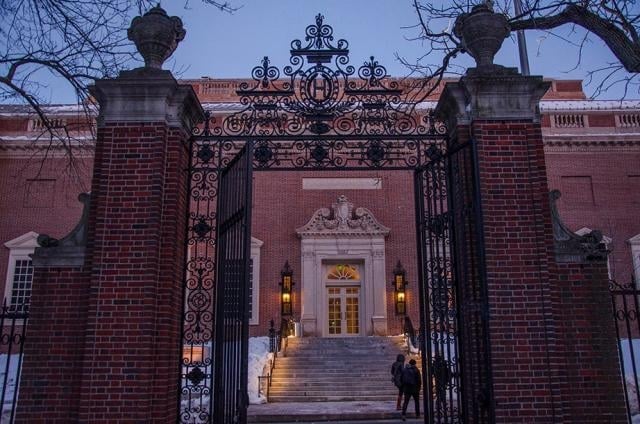You have /5 articles left.
Sign up for a free account or log in.

Harvard University
Would a Black or Latinx student be admitted to Harvard University or the University of North Carolina at Chapel Hill if they were white?
Research by three scholars suggests that their odds of admission would be much lower. At Harvard, the admit rate would fall from an already low 7.29 percent to 2.25 percent. The results appear in a working paper released by the National Bureau of Economic Research.
The research arrives as the Supreme Court is preparing to hear a case about affirmative action at the two universities examined. And two of the researchers have ties to the case. (Typically, much new research will come out before the Supreme Court makes its decision in the case.)
The researchers are Peter Arcidiacono, a professor of economics at Duke University, Josh Kinsler, an associate professor of economics at the University of Georgia and Tyler Ransom, an assistant professor of economics at the University of Oklahoma. Arcidiacono was an expert witness for Students for Fair Admissions, the group that sued Harvard and UNC. Kinsler served as a consultant for Students for Fair Admissions, which did not fund the work on the paper.
The 2.25 percent figure may strike some as too low. In the most recent class Harvard admitted, the university had a 3.19 percent admit rate.
So how did the researchers find 2.25 percent?
The data come from information submitted to the courts in the cases against Harvard and UNC. For Harvard, the data cover the Classes of 2014 to 2019. For UNC, the data cover the Classes of 2016 to 2021.
“For Harvard, we primarily focus on models that remove applicants who are athletes, legacies, connections of donors, and children of faculty and staff as including these applicants distorts the importance of factors such as academics,” the researchers said in their report. “The models of UNC admissions decisions take a similar approach, but distinguish between in-state and out-of-state applicants.”
So at both institutions, the questions being asked really is: Would a Black or Latinx student have been admitted if held to the same standards as white students who aren’t special in some way that the university favors (legacy children, donor children, athletes, etc.)?
At Chapel Hill, for in-state residents, the paper says that if Black students were evaluated like white students, the university would admit 17.8 percent of them. That compares to 30.5 percent who were admitted under current policies, the paper said.
“Thus, the 7.29 percentage point marginal effect at Harvard results in a quadrupling of the African American admit rate, while the 12.7 percentage point increase at UNC in-state increases the African American admit rate by a factor of 1.7,” the paper said.
The paper also cited evidence that “those who benefit the most from racial preferences (at least in terms of advantages in admissions) are those who come from higher socioeconomic status homes”—in other words, wealthy Black and Latinx students.
Latinx students also benefit but by a smaller amount. “Similar calculations [at Harvard] indicate that racial preferences increase the Hispanic admit rate by almost two and half times,” the paper said.
The paper said that, without affirmative action, the enrollment of new Black students would have fallen for the Classes of 2014 to 2019 from 1,163 to 324. Among new UNC students from North Carolina in the Classes of 2016 to 2021, African American and Latinx admits would fall by 864 and 273, respectively.
Harvard and UNC declined to talk about the paper.
Challenges to the Argument
Several things jump out about the analysis.
First, it is based on the assumption that the applicants are evaluated on the basis of grades and scores on either the SAT or ACT. In fact, Harvard and Chapel Hill consider a variety of factors (such as the essay, extracurricular activities, etc.).
Second, both institutions are now admitting applicants who opt not to submit SAT or ACT scores.
Shirley J. Wilcher, executive director of the American Association for Access, Equity and Diversity, said she did not have time to “carefully assess” the study. But, she said, “One might suggest caution, however, in making assumptions about the ‘harm’ that advantaged students are allegedly experiencing because of the presumed ‘preferences’ that underrepresented students are benefiting from.”
In addition, in a court ruling that upheld the legality of UNC’s affirmative action program, Judge Loretta C. Biggs wrote that Arcidiacono’s research (for that trial) was “more susceptible to picking up spurious correlations in the data.” So she rejected his research.




